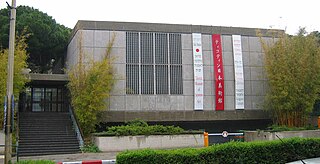
The Tikotin Museum of Japanese Art is a museum on the crest of Mount Carmel, in Haifa, Israel, dedicated to the preservation and exhibition of Japanese art. It is the only such museum in the Middle East. It was established in 1959 on the initiative of Felix Tikotin of the Netherlands, and Abba Hushi, who was the mayor of Haifa.

The Kodokan Judo Institute (公益財団法人講道館), or Kōdōkan (講道館), is the headquarters of the worldwide judo community. The kōdōkan was founded in 1882 by Kanō Jigorō, the founder of judo, and is now an eight-story building in Tokyo.

The Tokyo National Museum or TNM is an art museum in Ueno Park in the Taitō ward of Tokyo, Japan. It is one of the four museums operated by the National Institutes for Cultural Heritage, is considered the oldest national museum in Japan, is the largest art museum in Japan, and is one of the largest art museums in the world. The museum collects, preserves, and displays a comprehensive collection of artwork and cultural objects from Asia, with a focus on ancient and medieval Japanese art and Asian art along the Silk Road. There is also a large collection of Greco-Buddhist art. As of April 2023, the museum held approximately 120,000 Cultural Properties, including 89 National Treasures, 319 Horyuji Treasures, and 649 Important Cultural Properties. As of the same date, the Japanese government had designated 902 works of art and crafts as National Treasures and 10,820 works of art and crafts as Important Cultural Properties, so the museum holds about 10% of the works of art and crafts designated as National Treasures and 6% of those designated as Important Cultural Properties. The museum also holds 2,651 cultural properties deposited by individuals and organisations, of which 54 are National Treasures and 262 are Important Cultural Properties. Of these, 3,000 cultural properties are on display at one time, with each changing for between four and eight weeks. The museum also conducts research and organizes educational events related to its collection.
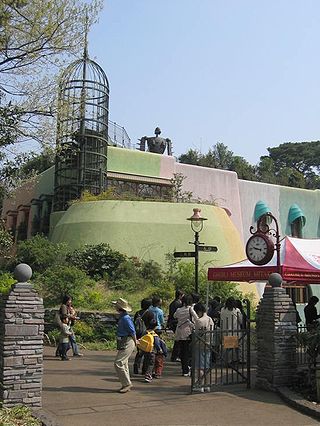
The Ghibli Museum is a museum showcasing the work of the Japanese animation studio Studio Ghibli. It is located in Inokashira Park in Mitaka, a western city of Tokyo, Japan. The museum combines features of a children's museum, technology museum, and a fine arts museum, and is dedicated to the art and technique of animation. Features include a replica of the Catbus from My Neighbor Totoro (1988), a café, bookstore, rooftop garden, and a theater for exclusive short films by Studio Ghibli.

In Japanese architecture, fusuma are vertical rectangular panels which can slide from side to side to redefine spaces within a room, or act as doors. They typically measure about 90 cm wide by 180 cm tall, the same size as a tatami mat, and are 2–3 cm (0.79–1.18 in) thick. The heights of fusuma have increased in recent years due to an increase in average height of the Japanese population, and a 190 cm height is now common. In older constructions, they are as small as 170 cm high. They consist of a lattice-like wooden understructure covered in cardboard and a layer of paper or cloth on both sides. They typically have a black lacquer border and a round finger catch.

The Nezu Museum, formerly known as the Nezu Institute of Fine Arts, is an art museum in the Minato district of Tokyo, Japan.
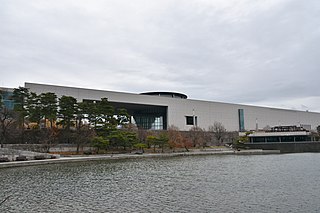
The National Museum of Korea (Korean: 국립중앙박물관) is the flagship museum of Korean history and art in South Korea. Since its establishment in 1945, the museum has been committed to various studies and research activities in the fields of archaeology, history, and art, continuously developing a variety of exhibitions and education programs.

Sunshine City is a building complex located in East Ikebukuro, Toshima, Tokyo, Japan. It has the 240-metre tall Sunshine 60 skyscraper at its centre. Sunshine City consists of four buildings: Sunshine 60, the main and tallest building, which includes corporate offices as well as restaurants; the Prince Hotel; the World Import Mart; and the Bunka Kaikan building. The complex sits on land that was once occupied by Sugamo Prison.

The Yokohama Archives of History in Naka ward, central Yokohama, near Yamashita Park, is a repository for archive materials on Japan and its connection with foreign powers since the arrival of Commodore Matthew Perry in 1853. The archives are next to Kaiko Hiroba where Commodore Perry landed to sign the Convention of Kanagawa.

The Edo-Tokyo Museum is a historical museum located at 1-4-1 Yokoami, Sumida-Ku, Tokyo in the Ryogoku district. The museum opened in March 1993 to preserve Edo's cultural heritage, and features city models of Edo and Tokyo between 1590 and 1964. It was the first museum built dedicated to the history of Tokyo. Some main features of the permanent exhibitions are the life-size replica of the Nihonbashi, which was the bridge leading into Edo; scale models of towns and buildings across the Edo Meiji, and Showa periods; and the Nakamuraza theatre.

Chiba Port Tower is a tower located in Chiba Port Park, Chūō-ku, Chiba, Chiba Prefecture, Japan. It is 125.1 m (410 ft) tall and has four stories. It was built in 1986.
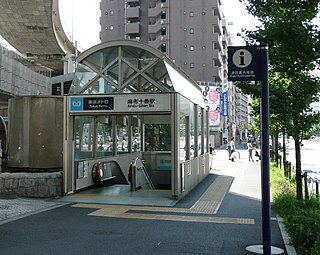
Azabu-juban Station is the name of two subway stations in Minato, Tokyo, Japan, one operated by Tokyo Metro and the other by Toei Subway.
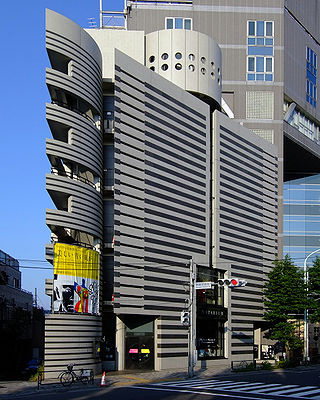
The Watari Museum of Contemporary Art (ワタリウム美術館), commonly referred to as Watari-um, is a museum of contemporary art located in Shibuya, Tokyo. Founded by Shizuko Watari and opened in 1990, the museum is near Gaienmae Station on the Tokyo Metro Ginza Line.

Yokohama Museum of Art, founded in 1989, is located in the futuristic Minato Mirai 21 district of the Japanese city Yokohama, next to the Yokohama Landmark Tower.
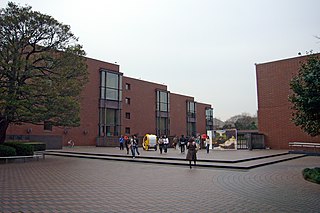
The Tokyo Metropolitan Art Museum is a museum of art located in Ueno Park, Tokyo, Japan. It is one of Japan's many museums which are supported by a prefectural government. The first public art museum in Japan, it opened in 1926 as the Tokyo Prefectural Art Museum and was renamed in 1943 after Tokyo became a metropolitan prefecture. The museum's current building was constructed in 1975 and designed by modernist architect Kunio Maekawa, remaining one his most well-known works today.
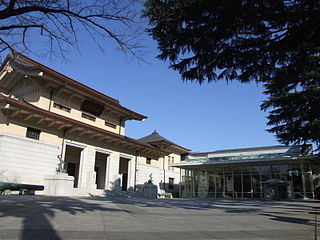
The Yūshūkan is a Japanese military and war museum located within Yasukuni Shrine in Chiyoda, Tokyo. As a museum maintained by the shrine, which is dedicated to the souls of soldiers who died fighting on behalf of the Emperor of Japan including convicted war criminals, the museum contains various artifacts and documents concerning Japanese war casualties and military activity from the start of the Meiji Restoration to the end of World War II. The museum was established in 1882, and describes itself as the first and oldest war and military museum in Japan. It has attracted controversy for its revisionism of Japan's wartime actions and militaristic past.

Oji Holdings Corporation is a Japanese manufacturer of paper products. In 2012 the company was the third largest company in the global forest, paper and packaging industry. The company's stock is listed on the Tokyo Stock Exchange and the stock is constituent of the Nikkei 225 stock index.

The National Library of Indonesia is the legal deposit library of Indonesia. It is located at Gambir, on the south side of Merdeka Square, Jakarta. It serves primarily as a humanities library alongside several others holding national responsibilities for science and agriculture. The national library was established in 1980 through a decree of the Ministry of Education and Culture and the consolidation of four different libraries. It maintains the status of a non-departmental government institution and is responsible to the President of Indonesia.
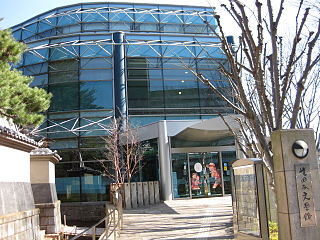
The Setagaya Literary Museum is an art museum in Minami-Karasuyama, Setagaya, Tokyo. It is owned by Setagaya City and operated by Setagaya Cultural Foundation. The museum was founded in April 1995 as a comprehensive museum of modern literature originated from Setagaya. It also functions as a library, as well as museum and archives.

The Embassy of the Islamic Republic of Afghanistan in Tokyo is the Islamic Republic of Afghanistan's diplomatic mission to Japan. It is also accredited to the Philippines and Singapore. The embassy is located in Minato-ku, Tokyo. The current Afghan ambassador to Japan is Shaida Mohammad Abdali, who presented his credentials in May 2021.




















